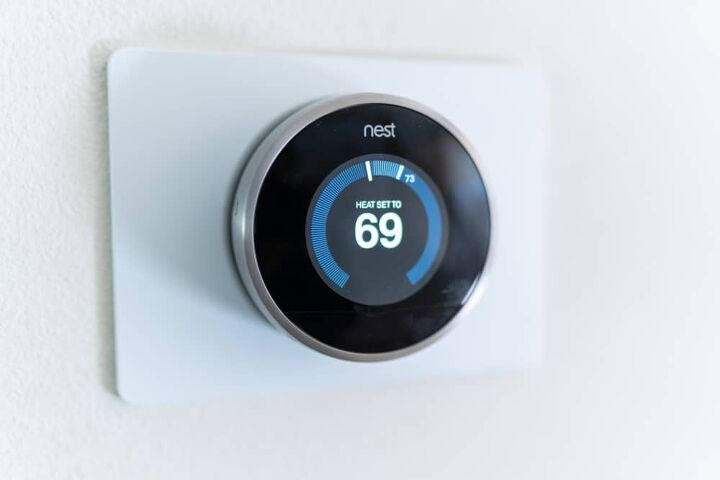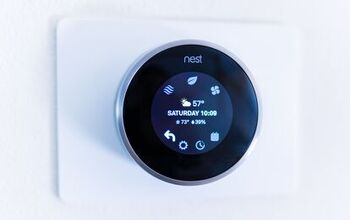Nest Thermostat Says Delayed? (Here Are 5 Ways to Fix It)

Nest thermostats are part of Google’s line of smart home products. Smart thermostats are a great way to manage the temperature in your home from anywhere while also lowering your energy costs on a monthly basis. You may notice that your Nest has a “delayed until” message.
A Nest thermostat can say “Delayed” if there is a problem with power or C-wire. Check your C-wire if your Nest says delayed while the internal battery charges and repair it if it is damaged. The delayed message serves as a safety measure when your Nest thermostat perceives a drop in power.
It can be alarming when a Nest thermostat says delayed, but there is nothing to worry about. Consider the delayed message a blessing in disguise while you figure out why there was a drop in power. Follow along as we explore what it means when a Nest thermostat says delayed.
Do You Need Your Thermostat Repaired or Reprogrammed?
Get free, zero-commitment quotes from pro contractors near you.

Safety Measure
Generally, the delayed message on a Nest thermostat serves as a safety measure. Nest thermostats are designed to run with a specific level of power. You will notice problems with connectivity and the function of your thermostat if it becomes underpowered.
The thermostat will say delayed if there if the thermostat power drops below what it is used to. On many models, a Nest will say delayed if the power drops to 3.6V or lower. It varies between thermostats, but it is common for a Nest to say delayed if you didn’t install it with a C-wire.
There are several factors involved in how your Nest handles power, but the C-wire is the most important. Nest thermostats contain an internal backup battery, but they are designed to work with proper wiring and a consistent current. The delay period serves to prevent electrical problems, and it is simply how your Nest reacts to changes in the current.
Low Power
Nest thermostats come with several useful functions, and you can easily drain your power if you use them all at once. Your nest has to work harder if you use several of the smart features that use Wi-Fi at once. Features such as motion sensors are helpful, but they can drain your battery and use a lot of power.
You may notice that your HVAC system doesn’t work as intended or your thermostat enters a delay mode. This is perfectly normal, and you can minimize the risk if you use less power. Run less smart features at once when you use your Nest thermostat.
Enter the settings and cancel functions that you don’t use or need to conserve power. When the thermostat fails to get the necessary power, there are problems with inconsistent fan operation, intermittent heating, and cooling, and, yes, even the “delayed until” message.
C-Wire
The C-wire on any thermostat is critical to its performance, and that’s especially true with Nest thermostats. You don’t need a C-wire for a Nest thermostat in all cases, but it certainly helps. A Nest can bounce back and work properly even when the battery doesn’t if you have a C-wire.
Think of the C-wire as a backup that allows you to use your Nest long after the battery dies. The internal battery only takes a few hours to charge, but the C-wire lets you use the thermostat during that time. Otherwise, you will enter a delay period with little to no control over your thermostat and settings.
Inspect your C-wire if you still get delayed messages on your Nest thermostat. You may need to adjust or replace your C-wire if it can’t retain power when your Nest charges the internal battery.
Impact
While it may be a pain to deal with that “delayed until” message, there is more at play than an error message. Most actions require a certain voltage level in order to activate them. When your Nest thermostat is dealing with low power, it may not be able to deliver the necessary voltage to get the job done.
If your Nest has features like automatic software updates, motion sensors, or Wi-Fi, it may not be able to use those features when power levels are too low. Since the power only flows to the thermostat when the heat or air conditioning are on, those other features may be lacking until a proper charge is received.
How To Install C-Wire
As stated previously, the Nest technically does not use a C-wire to operate. It may or may not come with one, but you will need to install one in order to get your thermostat working once again. There are a few options for installing the C-wire: hardwiring, using an adapter, or using the G-wire. You can also protect the AC compressor instead.
Hardwiring a C-Wire
The process of installing a C-wire is relatively straightforward. Basically, it means connecting both ends of the wire to the HVAC, the furnace in most cases, and the Nest thermostat. Whenever you work with anything beneath the casing, turn the power off. Safety should always come first and foremost.
Depending on the layout of your furnace, this could be a fairly big undertaking. The wiring runs behind the walls, so it may be a bit too difficult to properly get to them. When in doubt, bring in a professional to run those C-wires.
There is also technically a wireless C-wire connection. You can connect a C-wire through a sender and receiver. Something like Fast-STAT should work in an instance like this, especially if you are not keen on getting behind the walls.
C-Wire Adapter
Let’s say that you do not have the C-wire that you need. Without the wire, you can always use a C-wire adapter to do the job. There are adapters out there like the Fyve adapter. These are relatively easy to install and have been tested as compatible with the Nest thermostat.
The adapter works by plugging into a nearby outlet and then wiring directly into the Nest itself. The adapter feeds power into the thermostat, resolving the “delayed until” message. The good news is that these adapters come with instructions. Most of the steps are really easy to follow and all you will have to figure out is how to disguise the wires if they seem unsightly.
Repurposing the G-Wire
If you do not have access to a C-wire and don’t want to spend the money on an adapter, there is one other option: the G-wire. The G-wire is the green wire and it enables you to gain independent control over the blower fan. Don’t confuse the G-wire with your ground wire; they are totally different.
This process means removing the G-wire from its terminal within the thermostat, installing it the same way that you would a C-wire. This is a quick and effective way to get a continuous flow of power to your thermostat. The downside is that you will lose control over the ventilation fan.
There are a few other things to consider. One, make sure that the fan isn’t already connected to another piece of equipment. That will complicate using the G-wire. Two, if you have a zone panel, the G-wire is no longer an option. Finally, you may still need a jumper cable to connect into your empty G-terminal as well as the Y-terminal.
This is a short-term solution at best. It will get your Nest charging again, but it can be something of a pain in the long run. Look into one of the other options if you notice that your Nest is having the same recurring low power issue.
Consider Protecting Your Compressor
While it may not necessarily resolve the issue of a delay in the Nest thermostat, the AC compressor is vital to your entire system. Thermostats will help you to regulate and control your ventilation, air-conditioning, and heating systems.
The compressor plays a vital role within the system. The delay is meant to prevent short cycling of the air conditioning equipment. The delay helps to prevent any unnecessary wear and tear from occurring, giving the compressor a longer lifespan.
Regular maintenance is vital to the life of your HVAC system. It may seem like a hassle but will go a long way towards extending the life of all components. Small problems can add up over time if they are ignored. Save money by saving your system through proper cleaning and maintenance.
Do You Need Your Thermostat Repaired or Reprogrammed?
Get free, zero-commitment quotes from pro contractors near you.

Related Questions
Why does my Nest keep going offline?
A Nest thermostat can repeatedly go offline if the power drops below 3.6V. Your Nest thermostat cannot stay online if your network has a faulty or inconsistent connection. Wi-Fi interference is possible if there are other networks nearby, and that can affect your Nest’s connectivity.
Why does my Nest say away when I’m home?
Your Nest thermostat’s built-in sensor may be damaged or malfunctioning if it says “away” when you’re home. Enter the settings on your Nest display and adjust the Home/Away settings. There could be a problem with your Wi-Fi connection, Nest sensor, or the built-in GPS.
How long does Nest last without power?
A Nest thermostat can work for 2 ½ hours on average without power. Nest thermostats contain an internal backup battery that can last for up to 3 hours. The backup battery in a Nest thermostat is powerful, but the thermostat may not work as well as it would with standard power.
More Related Guides

Ryan Womeldorf has more than a decade of experience writing. He loves to blog about construction, plumbing, and other home topics. Ryan also loves hockey and a lifelong Buffalo sports fan.
More by Ryan Womeldorf











![10 Best Electric Lawn Mowers - [2022 Reviews & Top Rated Models]](https://cdn-fastly.upgradedhome.com/media/2023/07/31/9070486/10-best-electric-lawn-mowers-2022-reviews-top-rated-models.jpg?size=350x220)















